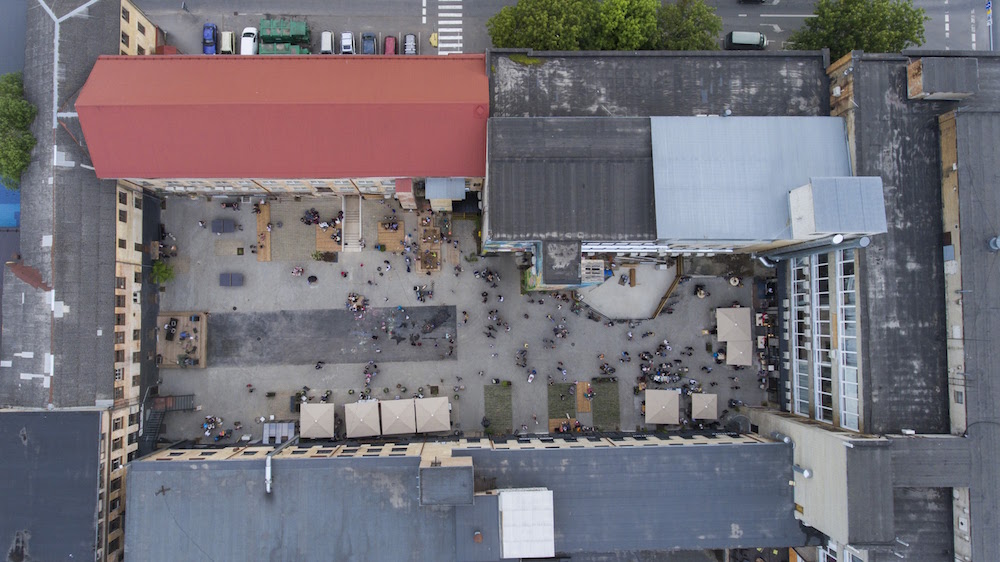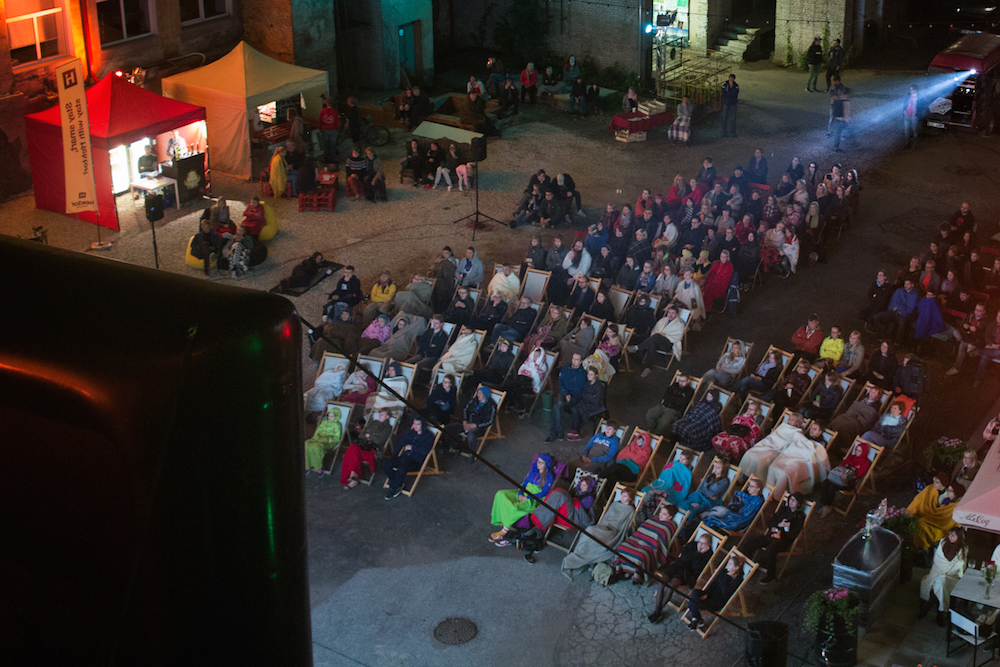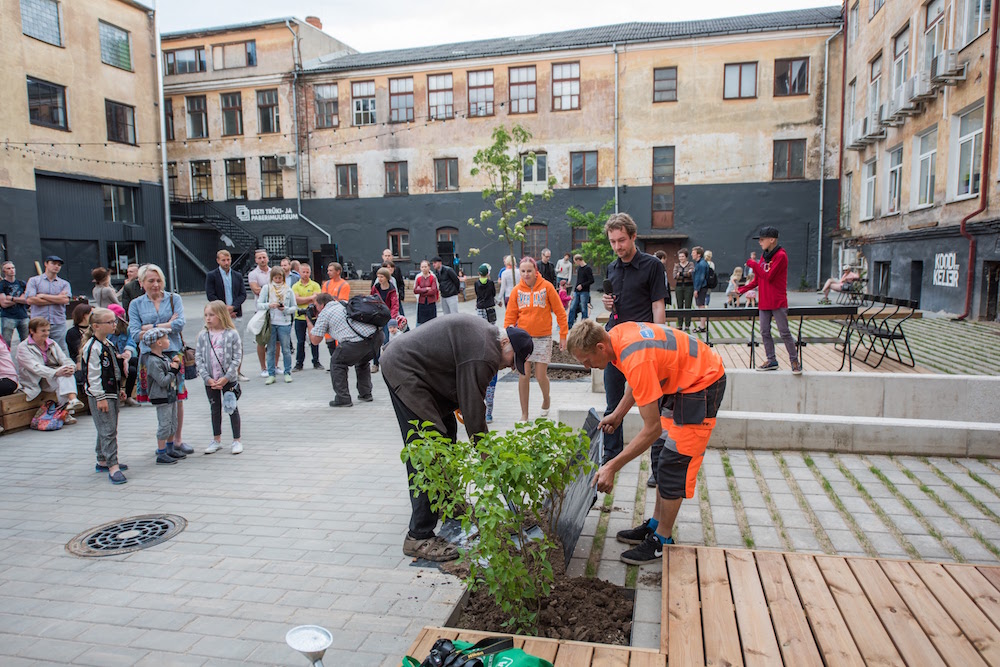Estonian culture factories and creative districts yesterday, today and tomorrow.
Yesterday
There was dankness, a hundred years’ worth of debris, asbestos and doors that opened into abyss. Flapping pigeons entered the twilight of the derelict halls through the holes in the roof. I was facing the hidden side of the city—a forgotten and abandoned urban wasteland right here, close to my home, right next to one of the busiest streets.
It will soon be ten years. Having witnessed the ventures of the Culture Factory Polymer and the Creative Hub (Kultuurikatel) in Tallinn, or catching a spark from the furnaces of the culture factories of Helsinki or Berlin, a few minds were excited enough to claim a large and deserted industrial block and breathe new life into it. Some of the co-conspirators who were associated with the GenClub (Genialistide Klubi) had already launched Müürileht, the culture magazine of ‘Tartu and the world’, to remedy the failure of the regular media to truly capture the buzz of the new decade. Settling into the Yeast Factory (Pärmivabrik) was a conquest, yet also an acupuncture treatment; an attempt to gain some purchase in the Monopoly game of capitalist realism where your value is determined purely by the real estate you own (even if only as a tenant) and also an attempt to prod the city of culture into life in the 21st century.
The Yeast Factory, its few years of vita nova and quick demise, is a textbook example of the rise and fall of the first generation culture factories in Estonia. Its tale is too long and tangled to be told here. It is easy to put the blame for the premature ending of this tale on the global financial crisis, as it indeed has been done later on by the parties involved (to stop bickering between themselves), yet would the Yeast Factory have endured if there had been no crisis—or if there had been another economic boom? We can only guess.
It is the hard and sober reality that beat cannot repair plumbing, art does not patch roof leaks, squatting romance brings no heat to the pipes. Someone must do the work and someone must crank the money mill wisely enough to keep all that sweating, huffing and puffing from repelling those who spurn such worship of mammon. If many a love has withered and died, failing to withstand the stress put on it by the mundanities of daily chores—what hope, indeed, is there for the youthful team spirit to remain steadfast?
And if the manufacturer of imagination fails to (or cannot or prefers not to) attract investors other than the local authorities only just getting used to the new reality of subcultural presence, the actual owner of the real estate will also fail to develop any true interest and sense of involvement in the endeavour. The excitement and enthusiasm of shock tourists, however, is fickle—the first party may feel like an enchanted dream, yet for how long will the magic endure if one has to keep peeing in the bucket and getting hit on the head with pigeons?
Empty and deserted, such is the state of this factory ever since. Polymer in Tallinn enjoyed a longer lease on its new life, but ended in a similar languishment. Tallinn Creative Hub which owes its existence to the 2011 European Capital of Culture campaign has become the poster kid of the establishment, hosting a series of events related to the Estonian EU Presidency and mentioning its subcultural past only in passing. Here endeth the first generation.

Today
Although Telliskivi Creative City was founded in 2009, only a year after the Yeast Factory, it progressed into a next generation ‘hub’ which evidently took in the lessons from the shortcomings of its predecessors both abroad and at home. Importantly, from the very outset, efforts were made to attract investments and guarantee hygiene on the premises. Not only was there better planning, but the time was more fortuitous as well—the publicity which the creative industries had received was paying off, a critical mass of hipsters had gained sufficient management and business skills and the founders were likely also spurred by the successes and disappointments of Tallinn’s year as the European Capital of Culture. It was precisely at this time when we could witness the emergence of an ambitiously and emphatically ‘Western’ self-esteem in new private and community initiatives, standing in constructive opposition to Tallinn’s city administration which had (and continues to have) one of its feet still firmly planted in Soviet times.

Let us also not forget the ascent of social media—it was also the period of the rapid expansion of Facebook and Twitter, offering novel opportunities for free-of-charge online advertising of club events, earrings or home-baked buns, furthermore serving as an unprecedentedly far-reaching technological medium for connecting communities. In his interviews, the leader of Telliskivi Creative City Jaanus Juss has spoken about selecting the new tenants according to their compatibility with the spirit of the place and existing dwellers—not unlike one chooses and accepts Facebook friends. In its own way, every friend list is a personal utopian project; a creative district whose development is guided by the same principles is the enactment of a similar utopia in public city space: in principle an open territory, but in many aspects an enclave populated by the privileged (singled out, admitted to membership and thus expected to be able to contribute to the shared economy) – mutually strengthening their bond in real and virtual life, having fun, creating, producing and consuming together.1

Telliskivi’s ambition to become a full-fledged utopian microcity is precisely what sets it apart from the earlier creative hubs nested in old industrial areas. Although an enclave, it has colonialist aspirations to expand its area of influence and spread its values: if the best jobs, creative opportunities, food and merriment, shops and parties are all concentrated in a relatively small area, its regular customers are also naturally inclined to shift their residence to the closest location possible. Thus, the Creative City has been one of the main driving forces behind the gentrification of the Kalamaja district. As indicated above, to a large extent it can be seen to express opposition to the stagnating general state of affairs in Tallinn where subcultures, street art and small entrepreneurs (those without any ties to the Centrist Party) have never been warmly welcomed. At the same time, Epp Vahtramäe, with her Master’s thesis on Telliskivi has suggested on the basis of conducted surveys that in Kalamaja and Pelgulinna districts, a segment of residents perceive the developments and preferences in the Creative City as alien, finding their identities excluded (just as there are those who regard the expanding and increasingly crowded ‘hub’ as becoming a sell out).2

Against this background, it is especially exciting to observe the development of the Widget Factory (Aparaaditehas), Telliskivi’s ‘spinoff’ in Tartu. On one hand, it is a diligent disciple of Tallinn in creating its own utopian microcity. On the other hand, its territory is somewhat more limited and its immediate support base much thinner—although the initial fears about its relative distance from the city centre appear to be mostly unfounded and the hipsters of Tartu Art College have made it their second home, not much comfortable residential space is to be found in the immediate vicinity. At the same time, the market for creative industries is also significantly poorer: it is not uncommon to have weekends when the Telliskivi area contains more people from Tartu than meanwhile in Tartu in all its alternative culture centres combined. Yet therein may also lie a potential for creative adaptation to the needs of a wider resident base dispelling the prejudice that the Widget Factory is an overly exclusive hipster paradise. For instance, if they have the wit to cherish the indomitable campness of the café Sodiaak, deeply entrenched in the immediate post-Soviet years, and to preserve it with as much assiduousness as they show in adapting the Aparaat restaurant to the tastes of the global creative class.3

Where the Widget Factory considerably differs from Tallinn is the former’s lack of defiance of municipal politicians and city administration—Lemmit Kaplinski, one of the masterminds behind the culture factory, is also a Social Democrat member of the city council and its culture committee. The city administration has actually developed some tolerance of subcultures and street art, and the creation of the Pocket Park (Taskupark) in the courtyard of the Widget Factory received funding from the city’s participatory budget. This rather synergetic co-functioning with the city administration may make it easier for the Widget Factory to carry out their activities, but also subdue their guerrilla ambitions—in Tartu they are delighted to have a new zebra crossing in the area whereas in Tallinn they name streets in Google Maps regardless of the established procedure.4 To what extent the culture factory and the city of Tartu together can succeed in growing and realising major urban development ambitions, we will see in the next few years (their partnership will also be tested in bidding for the title of the European Capital of Culture of 2024).
Tomorrow
What will become of the culture factories and creative districts of today, which distinctive features will characterise the next generation? Reliance on quality-sensitive, creatively and (virtual-) socially active interest groups has probably been inevitable at the launching phase of Telliskivi and Aparaaditehas, but in the longer run one should notice and mend rifts with the wider cultural environment. For this, probably an excellent opportunity has already been offered by carboot sales, popup markets and food alleys which extend into their surroundings; theatres and festivals which do not shoot their prices through the ceiling likely also possess a substantial potential in this regard. A community which possesses utopian goals and whose growth is governed by the rules of managing one’s Facebook profile is cozy and secure for the inner circle (no unwanted chavs or random element). However, if the general populace of the state and the city maintains its aversion to ‘hipster music’ and diversity in modern art and culture, perhaps it is time to consider different kinds of activities, at once more accessible and more outreaching. Not everyone can eventually be won over, yet opportunities can still be offered to more diverse audiences. The cognitive dissonance between the city of culture, extolled by the patrons of Tallinn Music Week on the basis of their idyllic Telliskivi experience, and the miserable and decaying post-Sovietism that refuses to disappear, should be apparent to anyone walking on the streets of Tallinn—how can this dissonance be reduced?

In Tartu, the social class and ethnic gaps are not that severe, yet we still should ask—what do the people of the Samelin factory and Tammelinn city district know about what is going on in their immediate neighbourhood? How many of the local families can be drawn to spend their time in the ‘Pocket Park’ and how likely are they to spend all-family time on the street fronts directly facing heavy road traffic? What influence will the Widget Factory have on the property development along the railway and when will the Hektor Design Hostel receive some tourist-friendly competition from other affordable lodging facilities? When will the currently homeless Elektriteater art house cinema carry out the takeover of the Ekraan cinema building which struggles to compete with the multiplexes and is located in the proximity of the culture factory? When, locked in each other’s embrace, will meet the eyes of the culture block and of the Tartu studio of the Estonian Public Broadcasting?
And will the cleanup and renovation campaign of the Widget Factory, although in most part very welcome, leave untouched those fantastic barely lit secret passages where I wander in those nights when I play records at Sodiaak and am currently having a break from the DJ duties, as if revisiting my memories in the early days of the Yeast Factory?

In major cities, are there still any overlooked potential sites available for such ‘hubs’? The usable old industrial sites have been surveyed both in Tallinn and Tartu, yet have largely been rejected (the boilerhouse of Turu Street was initially targeted as a continuation of Tartu culture factory—in terms of location, the site has great potential, but the buildings should be razed entirely and then completely rebuilt, the soil cleaned…) Lest we forget,, the government-funded Estonian National Museum in Tartu also aims to become (or has already become) a ‘culture factory’ of sorts and a pole of attraction stimulating the development in its neighbourhood. With partly clouded forecast, the complex in the city centre intended to house both the city library and the art museum (and then some) is still being planned.
If lacking any significant start-up capital, the creators of utopian cultural spaces should perhaps start smaller, more crowded and warmer. A few small-scale success stories can be cited: in Tartu, Genialistide Klubi bravely endures, café Barlova has become the hipster Mecca of the Karlova city district with its art exhibitions and music performances, Tartu Writers’ House is aiming to become a multifunctional centre under the aegis of the UNESCO City of Literature. In Tallinn, new and cozy places of similar kind may come into existence (deliberately) under the news radar. On the other hand, in the era of global mobility, in defiance of endless profit hunting, we can also see a proliferation of various ad hoc combinations, pop-up cafés, apartment exhibitions, one-off events, as well as urban nomadism and forest raves and island festivals which do not build any permanent connections with any particular space. The creative district of the next generation is online and in smartphones, today in a neighbour’s house, tomorrow in a forest cottage, the day after tomorrow—on the beach of an islet.

Writer, university lecturer, DJ and critic BERK VAHER heads the Tartu branch of the Estonian Writers Union and is one of the chief organisers of Tartu International Literature Festival Prima Vista. He has been involved in the founding of Tartu Culture Factory and the cultural monthly paper Müürileht;has participated in the preparation of several culture strategies of Tartu and the bids for Tartu to become a UNESCO Creative City and the European Capital of Culture; was a member of the Creative Council of Tallinn 2011.
HEADER photo by Rasmus Põld.
PUBLISHED in Maja’s 2018 winter edition (no 92).
1 This essay was written in summer 2017; now, in the wake of the controversy over Dark Diamonds MC open air photo exhibition having been removed from Telliskivi, it appears to have anticipated the manifestation of the more elitist and restrictive aspects of this insularity. (B. V.)
2 A short English summary of Epp Vahtramäe’s Master’s thesis “Sociocultural impacts of former industrial area revitalisation on the surrounding urban space: the case of Telliskivi creative district” is available in the article collection of the autumn symposium of young geographers entitled Väikesed pildid Eestist: geograafia karu-aabits [‘Snapshots of Estonia: A Geography Primer’], EGSN and EGEA-Tartu 2013-2014, http://egs.ee/wp-content/uploads/2014/12/Vaikesed_pildid_eestist_karu_aabits_2014.pdf
3 See, for example, Kyle Chayka “Same old, same old. How the hipster aesthetic is taking over the world”, https://www.theguardian.com/commentisfree/2016/aug/06/hipster-aesthetic-taking-over-world
4 Street naming was discussed by Jaanus Juss at a Tallinn Music Week Talks session at the pop-up restaurant Ungru on 1 April 2017.





